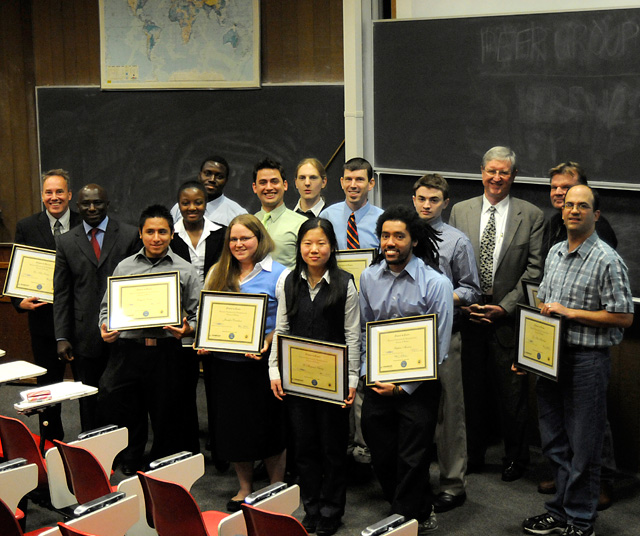
The eight-week program is named Research Experience for Undergraduates (REU). It is interdisciplinary and each year it affords 10 undergrads from underrepresented groups practical experience and intellectual growth in computer science.
“I learned more in this program than I learned in a year of classroom computer science,” says Kelvin Harry, who will be a junior next semester at the University of the Virgin Islands.
This summer’s curriculum instructed students in real-time mobile sketching of software designs. Using handheld devices such as cell phones or personal digital assistants (PDA’s), the undergrads came up with original software concepts. The exercise is geared to “fingertip collaboration”—designers working directly with hypothetical customer clients who do not necessarily understand the technology but want first-hand experience of how a software program is being tailored to their needs.
The REU projects spanned a number of fields, including fusion energy, graphic design in human-computer interaction and data mining. Each project requires students to fashion a design and make it concrete with a poster, a pamphlet, a scientific article and an oral presentation.
HSU senior Casey Vaughn is a studio art major with an emphasis in graphic design and he gives the REU training a resounding A+. “These eight weeks have taught me how to get into grad school, it’s prepped me for it,” he says. “And I also know that, with REU on my resume, I have a good chance for an internship at a big design firm like IDEO because I can show them I’ve done research in my field—which most graphic designers don’t do.”
Participants say they have picked up invaluable lessons about how to conduct research and the research process, as well as direct experience of the work ethic, team effort and meeting deadlines.
Eva Nesmith, who will be a sophomore this fall at South Carolina State University, Orangeburg, lauds the program’s challenges, which differ from standard classroom fare. “It’s real-life application—the classroom is more structure and theory—and you learn a lot about the work ethic,” Nesmith says. “Sometimes you have to put in hours outside the nine to five routine, and look beyond what [HSU Professor of Computer Science] Guy-Alain [Amoussou] requires. You have to take the initiative. I think it’s excellent.”
The REU also encourages undergrads to break out of their academic “shells.” As HSU senior Ezequiel Lares puts it, “I’m really used to working by myself. Now, working with a partner, listening to his ideas, it’s more creative and stimulates my ideas, too. Instead of doing homework by yourself, you get teamwork accomplishing a project.”
Another REU fan, Bradley Spaulding, a senior at Gordon College, Wenham, Massachusetts, says the training encourages autonomy as well as teamwork. His project was an interactive web application, employing geospatial technologies, to link online databases for monitoring the Klamath River Basin’s water quality. “For me, it’s very freeing to be given a project and just go. You don’t know what the answers are, you just tackle it and do the best you can. You really get behind it and invested in it, and it helps you grow that way, too.”
For Casey Vaughn, the aspiring graphic designer, the training has paid big dividends in the larger scheme of things. He draws a sharp line between “new computing” and “old computing.” By way of example, he cites the iPhone, the Internet-enabled “smartphone” with a multi-touch screen that replaces a keyboard, mouse or stylus. In the new computing, he says, it’s not just about the technology anymore and the function it performs. “It’s the way you interact with it that counts. In the new computing, every little aspect of the experience of using digital products needs to be taken into consideration, not only the appeal of the software, but the aesthetic design, a gray box versus a beautiful flat screen of brushed aluminum. The iPhone makes interacting with the world around you easier and more mobile.”
Casey and fellow HSU senior Jennifer Davidson envision a day when computers will be embedded in virtually every object, including human skin. That may offend a person’s sense of privacy, they acknowledge, but it could be life saving, too. Supposing you’re injured a world away in Sri Lanka and in need of immediate medical attention. Your whole medical history comes up in the native language on a handheld device and the doctor can treat you at once. “It can be scary to have a computer under your skin,” Casey concedes, “but it can also enrich your life.”
As for the REU experience, students are unanimous it fulfills its objectives. The National Science Foundation provides the funding to encourage students to go on to graduate school. Dr. Amoussou’s goal is “to train future generations of skilled designers, using an interdisciplinary approach that can be used in many professions. This is both a practical and inspiring summer study experience that motivates our undergraduates to pursue advanced degrees.”